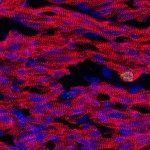Link to Pubmed [PMID] – 23250213
Development 2013 Jan;140(2):395-404
Anisotropies that underlie organ morphogenesis have been quantified in 2D, taking advantage of a reference axis. However, morphogenesis is a 3D process and it remains a challenge to analyze cell polarities in 3D. Here, we have designed a novel procedure that integrates multidisciplinary tools, including image segmentation, statistical analyses, axial clustering and correlation analysis. The result is a sensitive and unbiased assessment of the significant alignment of cell orientations in 3D, compared with a random axial distribution. Taking the mouse heart as a model, we validate the procedure at the fetal stage, when cardiomyocytes are known to be aligned. At the embryonic stage, our study reveals that ventricular cells are already coordinated locally. The centrosome-nucleus axes and the cell division axes are biased in a plane parallel to the outer surface of the heart, with a minor transmural component. We show further alignment of these axes locally in the plane of the heart surface. Our method is generally applicable to other sets of vectors or axes in 3D tissues to map the regions where they show significant alignment.





